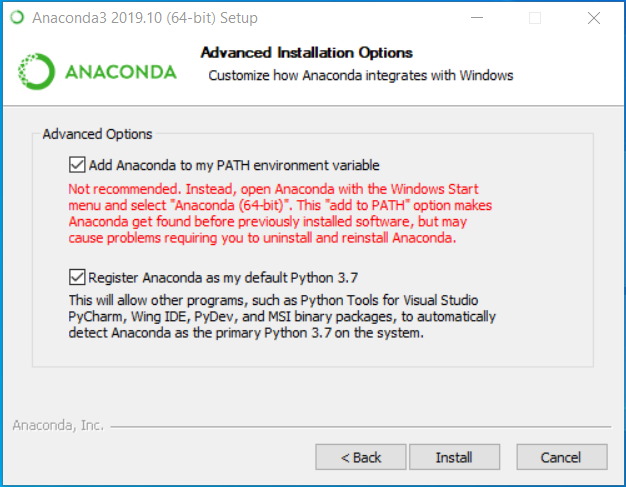
- #Xgboost python anaconda how to
- #Xgboost python anaconda install
- #Xgboost python anaconda upgrade
- #Xgboost python anaconda code
- #Xgboost python anaconda download
Next you need to create the Xgboost specific DMatrixdata format from the numpy array. X_train, X_test, y_train, y_test = train_test_split(X, y, test_size=0.2, random_state=42) Then you split the data into train and test sets with 80-20% split: from sklearn.cross_validation import train_test_split
#Xgboost python anaconda how to
Here I will use the Iris dataset to show a simple example of how to use Xgboost.įirst you load the dataset from sklearn, where X will be the data, y – the class labels: from sklearn import datasets

Now test if everything is has gone well – type python in the terminal and try to import xgboost: import xgboost as xgb
#Xgboost python anaconda install
This command installs the latest xgboost version, but if you want to use a previous one, just specify it with: pip install xgboost=0.4a30
#Xgboost python anaconda upgrade
I upgrade my python virtual environment to have no trouble with python versions: pip install -upgrade virtualenvĪnd finally I can install xgboost with pip (keep fingers crossed): pip install xgboost I install these ones from experience: sudo apt-get install -y make g++ build-essential gfortran libatlas-base-dev liblapacke-dev python-dev python-setuptools libsm6 libxrender1 Now, a very important step: install xgboost Python Package dependencies beforehand. It is important to install it using Anaconda (in Anaconda’s directory), so that pip installs other libs there as well: conda install -y pip libgcc
#Xgboost python anaconda download
You can download the installer for Windows, but if you want to install it on a Linux server, you can just copy-paste this into the terminal: wget īash Anaconda2-4.0.0-Linux-x86_64.sh -b -p $HOME/anacondaĮcho 'export PATH="$HOME/anaconda/bin:$PATH"' > ~/.bashrcĪfter this, use conda to install pip which you will need for installing xgboost. It simply installs all the libs and helps to install new ones. The best way I have found is to use Anaconda. In order to work with the data, I need to install various scientific libraries for python. Here I will be using multiclass prediction with the iris dataset from scikit-learn. Importance_type="gain", learning_rate=0.I had the opportunity to start using xgboost machine learning algorithm, it is fast and shows good results. XGBRegressor(base_score=0.5, booster="gbtree", colsample_bylevel=1,Ĭolsample_bynode=1, colsample_bytree=1, gamma=0, Reg_lambda=1, scale_pos_weight=1, seed=None, silent=None, Objective="multi:softprob", random_state=0, reg_alpha=0, N_estimators=100, n_jobs=1, nthread=None, Max_delta_step=0, max_depth=3, min_child_weight=1, missing=None, XGBClassifier(base_score=0.5, booster="gbtree", colsample_bylevel=1,Ĭolsample_bynode=1, colsample_bytree=1, gamma=0, learning_rate=0.1, Sns.regplot(expected_y, predicted_y, fit_reg=True, scatter_kws=) Print(an_squared_log_error(expected_y, predicted_y)) Print(metrics.r2_score(expected_y, predicted_y)) Here we have printed r2 score and mean squared log error for the Regressor. Here, we are using XGBRegressor as a Machine Learning model to fit the data. Here we have used datasets to load the inbuilt boston dataset and we have created objects X and y to store the data and the target value respectively. Print(nfusion_matrix(expected_y, predicted_y))

Print(metrics.classification_report(expected_y, predicted_y)) Here we have printed classification report and confusion matrix for the classifier. Now we have predicted the output by passing X_test and also stored real target in expected_y. Here, we are using XGBClassifier as a Machine Learning model to fit the data. X_train, X_test, y_train, y_test = train_test_split(X, y, test_size=0.25) Here we have used datasets to load the inbuilt wine dataset and we have created objects X and y to store the data and the target value respectively.
#Xgboost python anaconda code
We will understand the use of these later while using it in the in the code snipet.įor now just have a look on these imports. Here we have imported various modules like datasets, xgb and test_train_split from differnt libraries. So this recipe is a short example of how we can use XgBoost Classifier and Regressor in Python.įrom sklearn.model_selection import train_test_split In this we will using both for different dataset. Have you ever tried to use XGBoost models ie.


 0 kommentar(er)
0 kommentar(er)
